
The soldier flies are a family of flies. The family contains over 2,700 species in over 380 extant genera worldwide. Larvae are found in a wide array of locations, mostly in wetlands, damp places in soil, sod, under bark, in animal excrement, and in decaying organic matter. Adults are found near larval habitats. They are diverse in size and shape, though they commonly are partly or wholly metallic green, or somewhat wasplike mimics, marked with black and yellow or green and sometimes metallic. They are often rather inactive flies which typically rest with their wings placed one above the other over the abdomen.
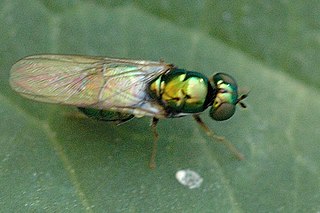
Microchrysa is a genus of soldierfly belonging to the family Stratiomyidae. There has been some confusion with the synonym Chrysomyia of Macquart, 1834, causing some members of the genus Chrysomya of Robineau-Desvoidy, 1830 to be placed erroneously in this genus.

Nemotelus is a genus of soldier flies in the family Stratiomyidae. Nemotelus is known from the Nearctic, Afrotropical and the Palaearctic regions.

Beris is a genus of flies in the family Stratiomyidae. They are also referred to as the false soldier fly. As described by Latreille in 1802, these are small to medium sized flies with metallic colors.

Actina is a genus of flies in the family Stratiomyidae.
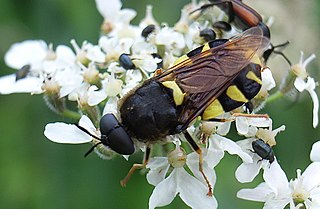
Stratiomyinae is a subfamily of flies in the family Stratiomyidae.

Pachygastrinae is a subfamily of flies in the family Stratiomyidae.
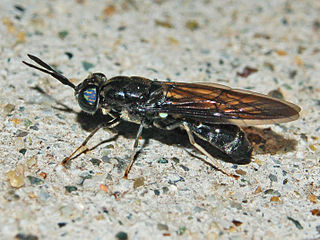
Hermetia is a genus of flies of the family Stratiomyidae.
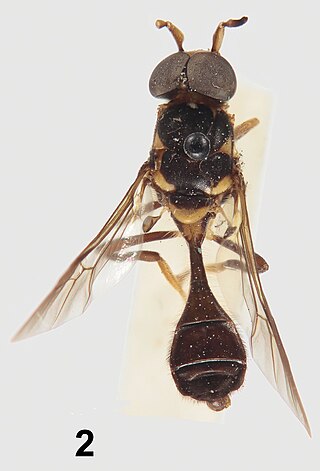
Parastratiosphecomyia stratiosphecomyioides is a species of fly in the family Stratiomyidae. It is native to Thailand. Its genus name comes from Ancient Greek, meaning "Near soldier wasp-fly", with its specific epithet meaning "wasp fly-like". It is considered to be the animal with the longest valid scientific name; the name Gammaracanthuskytodermogammarus loricatobaicalensis, an amphipod described in 1926 by Benedykt Dybowski, was longer, but was suppressed and is no longer valid, and the bacterium Myxococcus llanfairpwllgwyngyllgogerychwyrndrobwllllantysiliogogogochensis has the longest name of any organism, but it is not an animal. P. stratiosphecomyioides, sometimes referred to as the Southeast Asian soldier fly, was described in 1923 by British entomologist Enrico Brunetti. This insect is usually between 10.3 and 10.4 mm.
Trichochaeta is a genus of flies in the family Stratiomyidae.
Hedriodiscus truquii is a species of soldier fly in the family Stratiomyidae.

Allognosta is a genus of soldier flies in the family Stratiomyidae.
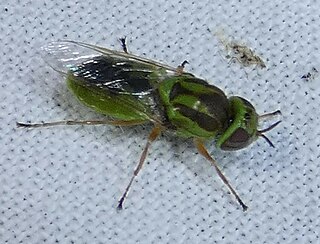
Hedriodiscus trivittatus is a species of soldier fly in the family Stratiomyidae.
Caenocephaloides is a genus of flies in the family Stratiomyidae.
Evaza is a genus of flies in the family Stratiomyidae.
Salduba is a genus of flies in the family Stratiomyidae.
Odontomyia aequalis is a species of soldier fly in the family Stratiomyidae.
Odontomyia cinctilinea is a species of soldier fly in the family Stratiomyidae.










